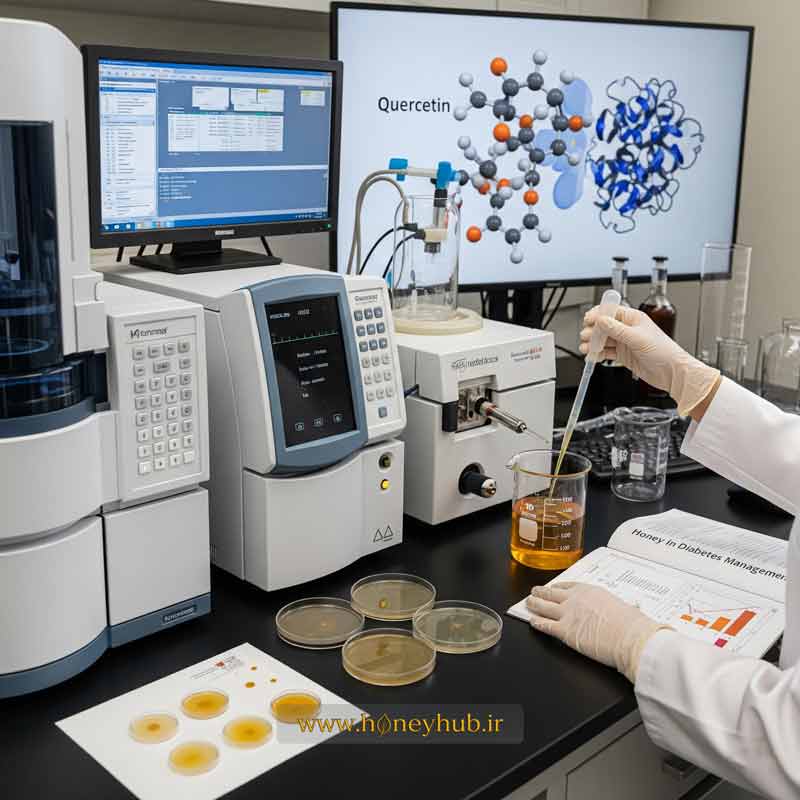Ваша моцарелла не тянется или горит? Секрет в науке. От процесса «паста филата» до решающей роли созревания...
Мёд против диабета: подсластитель или умное терапевтическое средство?
Для миллионов людей, живущих с диабетом, каждый прием пищи — это точный расчет, а каждый сладкий вкус — момент сомнения. Среди всего этого мёд, жидкое золото, занимавшее почетное место в традиционной медицине на протяжении тысячелетий, теперь подвергается современной оценке. Следует ли его внести в черный список вместе с сахаром, или же современная наука раскрыла секреты, которые представляют мёд не как простой сахар, а как метаболический модулятор (Metabolic Modulator)? Эта статья — глубокое погружение в мир мёда и диабета для ответа на этот жизненно важный вопрос. Мы надеемся, что это руководство — это тщательная попытка пролить свет на неясности, связанные с диабетом и употреблением мёда. Пожалуйста, оставайтесь с нами до конца.

Сложный состав натурального мёда
Чтобы понять влияние мёда, мы должны выйти за рамки его поверхностного определения как «сладкого вещества». Мёд — это перенасыщенный сахарный раствор, состоящий в основном из фруктозы (~38%) и глюкозы (~31%), а также около 17% воды. Но настоящая магия мёда кроется в оставшихся 2%; это сложная смесь из более чем 200 биологически активных соединений, подробно описанных в обширных обзорных исследованиях:
- Полифенолы и флавоноиды: Эти соединения являются основой терапевтических свойств мёда. Молекулы, такие как кверцетин (Quercetin), кемпферол (Kaempferol), хризин, пиноцембрин и галловая кислота, обладают мощными антиоксидантными и противовоспалительными свойствами, которые напрямую противодействуют патофизиологии диабета.
- Ключевые ферменты: Ферменты, добавляемые пчелами в нектар, такие как диастаза и инвертаза, не только способствуют пищеварению, но и являются показателями чистоты и сырого состояния мёда. Фермент глюкозоксидаза также в присутствии воды производит перекись водорода (мягкое антимикробное средство).
- Специфические для региона соединения: В зависимости от цветочного источника, в мёде обнаруживаются уникальные соединения. Самый известный пример — метилглиоксаль (MGO) в мёде манука, который придает ему исключительную антимикробную активность.
Эта сложная структура — наш первый ответ любознательному читателю: Нет! Мёд — это не просто «сахар и вода». Это «функциональный пищевой продукт» (Functional Food) с потенциалом влиять на метаболические пути организма так, как никогда не сможет рафинированный сахар.
Эпидемия диабета и необходимость пересмотра подходов
Статистика вызывает тревогу. Международная диабетическая федерация (IDF) в своем последнем отчете прогнозирует, что к 2045 году более 780 миллионов человек во всем мире будут жить с диабетом. Диабет 2-го типа, на который приходится более 90% случаев, является заболеванием, связанным с образом жизни, основной характеристикой которого является инсулинорезистентность. В этом состоянии клетки организма не реагируют должным образом на гормон инсулин, и сахар накапливается в крови. В этой перспективе поиск натуральных соединений, которые могут помочь улучшить чувствительность к инсулину, является необходимостью.
Анализ антидиабетических механизмов мёда: сложный биохимический оркестр
Положительный эффект мёда на управление диабетом не является результатом «волшебной пули» или единого механизма, а скорее сложного взаимодействия и синергии десятков биологически активных соединений, которые одновременно нацелены на несколько ключевых патофизиологических путей при диабете. Далее мы подробно рассмотрим эти механизмы на основе последних научных данных.
А) Улучшение чувствительности к инсулину и клеточной сигнализации
На клеточном уровне инсулинорезистентность означает, что «замки» инсулиновых рецепторов на поверхности клеток «заржавели» и не реагируют должным образом на «ключ» инсулина. Полифенольные соединения мёда, такие как кверцетин, кемпферол и кофейная кислота, действуют как «природные сенсибилизаторы инсулина». Они активируют сигнальный путь PI3K/Akt, главный путь передачи сигналов инсулина, что вызывает перемещение транспортеров глюкозы (GLUT4) на поверхность мышечных и жировых клеток. Это действие увеличивает способность клетки поглощать глюкозу из крови, помогая снизить уровень сахара в крови.
Научный источник: Erejuwa, O. O., et al. (2016). Honey supplementation in diabetes mellitus: a systematic review. Journal of the American College of Nutrition.
Б) Защита бета-клеток поджелудочной железы путем ингибирования окислительного стресса
Бета-клетки поджелудочной железы — это фабрики по производству инсулина в организме. В условиях гипергликемии (высокий уровень сахара в крови) эти клетки подвергаются сильному «окислительному стрессу», что приводит к избыточному производству свободных радикалов (ROS). Эти разрушительные молекулы повреждают структуру бета-клеток, подталкивая их к запрограммированной клеточной смерти (апоптозу). Мёд, особенно более темные сорта, богатые фенольными антиоксидантами, создает защитный щит для этих бета-клеток, нейтрализуя эти свободные радикалы. Этот цитопротекторный эффект помогает поддерживать функцию поджелудочной железы в долгосрочной перспективе.
Научный источник: Ranneh, Y., et al. (2021). Honey and its nutritional and anti-inflammatory effects. International Journal of Molecular Sciences.
В) Модуляция системного воспалительного ответа
Диабет 2-го типа по своей природе является воспалительным заболеванием. Хроническое низкоуровневое воспаление является одной из основных причин инсулинорезистентности. Флавоноиды в мёде могут ингибировать ключевые воспалительные пути, такие как путь NF-κB (ядерный фактор каппа B). Этот путь контролирует выработку многих провоспалительных цитокинов (таких как TNF-α и IL-6). Ингибируя этот путь, мёд помогает снизить общий уровень воспаления в организме, тем самым улучшая реакцию клеток на инсулин.
Научный источник: Meo, S. A., et al. (2017). Role of honey in modern medicine. Journal of Ayub Medical College Abbottabad.
Г) Замедление усвоения углеводов путем ингибирования пищеварительных ферментов
Один из прямых и интересных механизмов мёда — его влияние на пищеварительные ферменты. Ферменты альфа-амилаза и альфа-глюкозидаза ответственны за расщепление сложных углеводов на простые сахара для усвоения. Некоторые соединения в мёде могут ингибировать активность этих двух ферментов. Это ферментативное ингибирование замедляет процесс переваривания и усвоения углеводов и предотвращает резкие скачки сахара в крови после еды (постпрандиальная гипергликемия). Этот эффект аналогичен действию некоторых пероральных препаратов от диабета, таких как акарбоза.
Научный источник: Samarghandian, S., et al. (2017). Honey and Health: A Review of Recent Clinical Research. Pharmacognosy Research.
Д) Ингибирование образования конечных продуктов гликирования (AGEs)
Конечные продукты гликирования (AGEs) — это вредные молекулы, образующиеся в результате неферментативной реакции сахаров с белками и жирами в организме. При высоком уровне сахара в крови образование AGEs ускоряется. Накопление этих молекул в различных тканях (таких как кровеносные сосуды, почки и нервы) вызывает их уплотнение, воспаление и повреждение, и является причиной многих долгосрочных осложнений диабета. Фенольные соединения в мёде могут предотвращать образование AGEs, улавливая промежуточные соединения, такие как метилглиоксаль, тем самым помогая уменьшить осложнения диабета.
Научный источник: Kaka, U., et al. (2021). Honey and its role in the management of chronic diseases. Molecules.
Е) Модуляция гормонов аппетита и насыщения
Управление весом является важной частью управления диабетом 2-го типа. Данные свидетельствуют о том, что мёд, по сравнению с обычными сахарами, может вызывать более благоприятную реакцию гормонов, регулирующих аппетит. Некоторые исследования показали, что употребление мёда может подавлять секрецию грелина (Ghrelin), известного как «гормон голода», и одновременно повышать уровень гормонов насыщения, таких как пептид YY (PYY) и лептин. Эти гормональные изменения могут помочь уменьшить тягу к еде и лучше контролировать потребление калорий.
Научный источник: Larson-Meyer, D. E., et al. (2010). Effect of honey versus sucrose on appetite, plasma glucose, insulin, and ghrelin concentrations in women. Journal of the American College of Nutrition.
Ж) Модуляция микробиома кишечника и укрепление оси кишечник-поджелудочная железа
Как уже упоминалось, это очень активная область исследований. Олигосахариды в мёде действуют как пребиотик, увеличивая популяцию полезных кишечных бактерий, таких как Bifidobacterium. Эти бактерии производят короткоцепочечные жирные кислоты (SCFAs), которые не только улучшают здоровье кишечника, но и стимулируют секрецию гормона GLP-1, помогая поджелудочной железе оптимально выделять инсулин, а мозгу — контролировать аппетит.
Научный источник: Zinatizadeh, M. R., et al. (2021). The effects of honey and its components on the gut microbiota. Nutrients.
Клинические доказательства: мета-анализы и испытания на людях
Очень недавний и всеобъемлющий мета-анализ, опубликованный в ноябре 2022 года в журнале Nutrition Reviews, который включал результаты 18 клинических испытаний, показал, что употребление мёда, особенно сырого, оказывает положительное влияние на кардиометаболические показатели.
«Кардиометаболические показатели» — это меры, которые показывают здоровье сердца, кровеносных сосудов и обмена веществ, такие как уровень сахара и жиров в крови. Это крупное исследование показало, что натуральный мёд полезен для контроля этих жизненно важных показателей.
Следующая таблица обобщает эти и другие результаты исследований:
| Ключевой параметр | Эффект контролируемого потребления натурального мёда | Научный источник |
|---|---|---|
| Глюкоза в плазме натощак (FPG) | ↓ Значительное снижение | Nutrition Reviews (2022) |
| Холестерин ЛПНП (плохой холестерин) | ↓ Значительное снижение | Nutrition Reviews (2022) |
| Триглицериды (ТГ) | ↓ Значительное снижение | Clinical Nutrition (2019) |
| Воспаление (уровень СРБ) | ↓ Заметное снижение | Phytotherapy Research (2020) |
«Ключевым выводом этого исследования было то, что употребление около 40 граммов (примерно 2 столовые ложки) мёда в день в течение 8 недель значительно улучшило уровень глюкозы натощак и липидный профиль у участников».
Гликемический индекс (ГИ) и разумный выбор вида мёда
Гликемический индекс — это мера того, как быстро пища повышает уровень сахара в крови. Продукты с низким ГИ (ниже 55) предпочтительнее для людей с диабетом. ГИ мёда варьируется в зависимости от его цветочного источника.
| Название мёда | Приблизительный гликемический индекс | Ключевая особенность и вероятный механизм |
|---|---|---|
| Клеверный мёд | ~ 32 | Очень низкий ГИ, мягкий вкус. |
| Тимьяновый мёд | ~ 35 | Низкий ГИ, высокое содержание антиоксидантов. |
| Мёд зизифуса (Сидр) | ~ 43 | Содержит соединения, ингибирующие фермент альфа-глюкозидазу, что замедляет усвоение глюкозы. (Источник) |
| Астрагаловый мёд | ~ 45 | Сильное противовоспалительное действие благодаря наличию флавоноидов. |
| Гречишный мёд | ~ 51 | Самый высокий уровень полифенолов и антиоксидантной способности (ORAC). (Источник) |
| Мёд манука (MGO 100+) | ~ 57 | Сильное противовоспалительное и антимикробное действие. |
Научный протокол потребления: доза, время и меры предосторожности
Чтобы извлечь пользу из мёда и минимизировать риски, необходимо соблюдать научный протокол:
- Безопасная дозировка: На основании существующих клинических данных, суточная доза от 20 до 40 граммов (около 1-2 столовых ложек) была признана безопасной и эффективной в различных исследованиях. Рекомендуется начинать с меньшей дозы.
- Оптимальное время и разумное сочетание: Чтобы уменьшить гликемический ответ, никогда не употребляйте мёд отдельно натощак. Сочетайте его с источниками клетчатки (например, порошком цейлонской корицы), белка (греческий йогурт) или здоровых жиров (орехи).
- Абсолютное противопоказание: Пациентам с плохо контролируемым диабетом (HbA1c > 9%) или тем, кто испытывает сильные колебания сахара в крови, следует избегать употребления мёда до стабилизации состояния.
Заключение: от суждения к разумному использованию
Научные данные ясно показывают, что натуральный мёд — это не простой сахар. Это функциональный пищевой продукт, который при разумном выборе (сырой, монофлорный, с низким ГИ) и контролируемом, протокольном потреблении может стать мощным инструментом в арсенале управления диабетом благодаря множеству механизмов. Ключевые слова: «выбор», «контроль» и «знание».
Часто задаваемые вопросы специалистов (FAQ)
Может ли мёд заменить препараты от диабета, такие как метформин?
Категорическое нет. Это опасное заблуждение. Мёд — это «вспомогательная терапия» (Adjuvant), а не замена жизненно важных лекарств. Его роль — улучшить общее управление заболеванием наряду с основным лечением.
Почему некоторые исследования сообщают о повышении уровня сахара в крови после употребления мёда? Разве это не противоречие?
Ответ кроется в двух факторах: качестве и количестве. В этих негативных исследованиях часто использовался промышленный и пастеризованный мёд (который практически является сахарным сиропом) или очень высокие дозы, что противоречит научному протоколу потребления.
Полезен ли мёд при диабете 1-го типа?
Управление диабетом 1-го типа гораздо более чувствительно. Мёд можно использовать как часть точного подсчета углеводов для управления гипогликемией (низкий уровень сахара в крови) или как подсластитель в сбалансированном приеме пищи, но каждый грамм углеводов должен быть тщательно подсчитан и сопоставлен с дозой инсулина. Консультация с эндокринологом обязательна.
Доверяйте науке. Выбирайте качество.
Для специалистов и информированных потребителей, ищущих чистоту и эффективность, мы в HoneyHub предлагаем коллекцию монофлорных и протестированных в лаборатории сортов мёда из Ирана. Каждый продукт имеет определенный профиль и гарантию качества, чтобы вы могли с полной уверенностью добавить науку и природу в свой рацион.
Ознакомиться с нашей коллекцией терапевтических и специализированных сортов мёда




















Последние комментарии